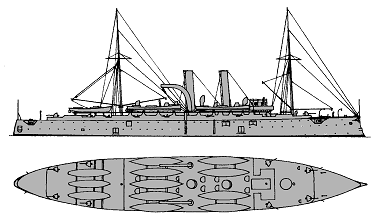

Vulcan 1891
|
Name |
No |
Yard No |
Builder |
Laid down |
Launched |
Comp |
Fate |
|
Vulcan |
N70, N4A |
Portsmouth DYd |
18.6.1888 |
13.6.1889 |
7/1891 |
submarine depot ship 1914 |
|
Displacement normal, t |
6620 |
|
Displacement full, t |
|
|
Length, m |
113.7 oa 106.7 pp |
|
Breadth, m |
17.7 |
|
Draught, m |
6.71 |
|
No of shafts |
2 |
|
Machinery |
2 VTE, 4 double-ended + 1 auxiliary single-ended boiler |
|
Power, h. p. |
natural draught: 8167, forced draught: 12000 |
|
Max speed, kts |
natural draught: 18, forced draught: 20 |
|
Fuel, t |
coal 1000 |
|
Endurance, nm(kts) |
12000(10) |
| Armour, mm | steel?; deck: 127 amidships and 51 at the ends, CT: 152, engine hatches: 127 |
|
Armament |
8 x 1 - 120/40 QF Mk I/II/III/IV, 12 x 1 - 47/40 3pdr Hotchkiss Mk I, 12 x 1 - 11.4/94, 6 TT (1 fwd aw, 2 beam aw, 1 aft aw, 2 beam sub,), 9 2nd class torpedo boats |
|
Complement |
432 |
Project history:
Vulcan was purpose-built, but both Vulcan and Hecla played
a very similar role in the development of the British torpedo force. Each
carried a number of Second Class TBs, and were fitted to service other TBs and
to see to the torpedo and mining needs of a fleet. Both served, one after the
other, with the Mediterranean Fleet, and both were commanded by a succession of
distinguished officers who were amongst the leading torpedo specialists. Many of
the most important experiments in torpedo tactics were carried out under their
control. Had war come no doubt the two ships would have proved useful launching
strikes with their small TBs against enemy bases.
Vulcan was a most unusual vessel, built with the
general appearance, lines and speed of a cruiser, and a respectable armament of
her own. Her main purpose in wartime would have been to launch her TBs against
the enemy, though she also had the full equipment of a depot ship. Her
appearance was much as that of contemporary cruisers, except for the
distinguishing feature of her two large 'goose neck' cranes, used for embarking
and disembarking her boats. Like the cruisers of the time she had a protective
deck.
Her trials were delayed because of trouble both with other
vessels with similar boilers and with her own boilers, and she became one of the
victims in the 'battle of the boilers' which raged over the type of boilers to
adopt in the early 1890s. In 1902 she was reboilered completely. She suffered
from other teething troubles, as some of the hull structure proved somewhat weak
and had to be strengthened before completion. However her relatively wide beam
in proportion to her length produced a reasonable performance.
Modernizations:
1902: re-boilered
Naval service: In 1914 Vulcan was converted to submarine depot ship. In 1931 she became a training hulk and was renamed Defiance III, BU in December 1955.

Vulcan
© Ivan Gogin, 2008-13